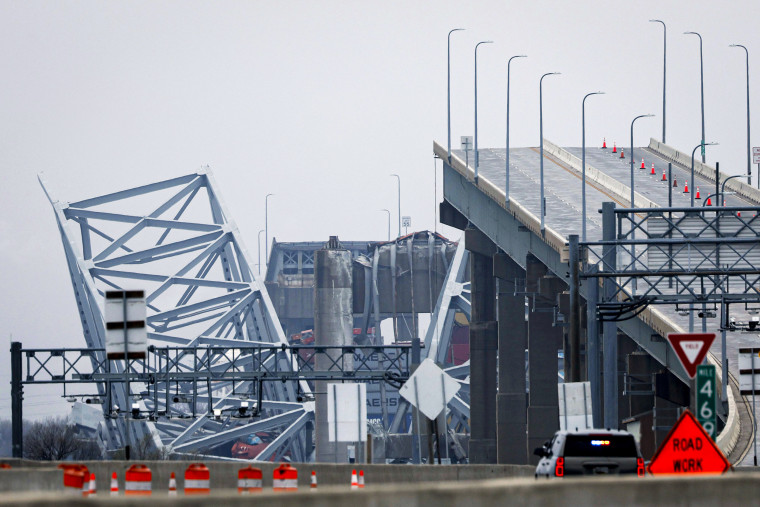DUNDALK, Md. — The livelihoods of thousands of workers who process goods passing through the Port of Baltimore hang in the balance as cargo shipments grind to a halt after a container ship crashed into the Francis Scott Key Bridge this week.
“These longshore workers, if goods aren’t moving, they’re not working,” Transportation Secretary Pete Buttigieg said following Tuesday’s crash, which killed six construction workers on the bridge when it collapsed into the Patapsco River. “They’re likely working right now, but that work won’t last long, and that’s one of our main areas of concern.”
Buttigieg noted the port produces $2 million in wages each day for the workers who make a living there, like crane technician Steve Rehak and his two sons.
“It’s pretty devastating,” said Rehak, 61, who added that he has worked at the port for 14 years. “When the ships aren’t here, you’re not making any money.”
Rehak says he will still work for the foreseeable future conducting preventive maintenance and repairs, but his hours have been cut to 40 hours per week — eliminating lucrative overtime.
“This is gonna be tough on them,” he said about his sons’ financial stability.
While crane technicians typically work around the clock regardless of cargo traffic, longshoremen work only when ships are present.
For Shawn Jackson, a longshoreman daily hire, the uncertainty is the hardest part.
“It’s the stress of not knowing,” he said of the lack of a timeline for the port’s reopening.
“The workers are worried,” said Tim Krajewski, secretary-treasurer for the International Longshoremen’s Association’s Local 333 chapter. “It’s a family-sustaining job, and them losing all that income — you’re not just talking severances, you’re talking flat cut when ships don’t come in, period.” Most workers take shifts day by day.
The Port of Baltimore, which comprises publicly and privately owned marine terminals, said Friday that despite speculation, “the fact of the matter is we do not know” when the channel will reopen. The state of Maryland estimates that roughly 15,300 direct jobs are generated by the critical shipping hub and 140,000 jobs are linked to it.
Maryland Gov. Wes Moore has repeatedly said that re-opening the port is one of the main priorities — a point he reiterated at a news conference on Saturday.
Moore said the Small Business Administration accepted a request to approve a disaster declaration, granting small businesses affected by the tragedy the opportunity to apply for low-interest loans of up to $2 million.
“They’re gonna help us ensure that our small businesses get the cash that they need to pay their bills and to keep people employed,” he said Saturday.
Applications need to be submitted online by Dec. 30, 2024.
The local chapters of the ILA are set to hold an emergency meeting on Monday to discuss a path forward. In the meantime, union officials are advising members to call their mortgage, car and credit card lenders to ask for deferred payments.
State lawmakers on Friday introduced a bill to provide temporary financial relief for workers and businesses affected by the port’s closure.
The proposed Protecting Opportunities and Regional Trade Act — or PORT Act — includes support for regularly paid port workers who don’t qualify for unemployment, assistance for businesses that need help retaining their local workforce, and incentives for companies to keep their work in Baltimore long term, instead of permanently relocating to another port where ships are being diverted, such as Wilmington, Delaware, or Norfolk, Virginia.
The legislation is led by state Senate President Bill Ferguson (D), who represents the district where the port is located. He hopes to take lessons learned from the pandemic — during which the port remained open — and apply them to Maryland’s current economic emergency.
“If we could help support small businesses and keep people employed in those positions, that was more efficient and a better way to help stabilize the small businesses, rather than having them lay off their entire team and then just hope for a time in the future that they can re-employ them back into those positions when the channel’s back open,” Ferguson told NBC News.
If passed, the measures would immediately go into effect upon Gov. Moore’s signature. The state’s General Assembly adjourns just after midnight on April 9.
Until then, it’s a waiting game.
“Summertime is our busy time,” Krajewski said. “The next couple of months was supposed to ramp up into a very busy season, so we really want that channel to be open as quickly as possible.”
Last year was record-shattering for the Port of Baltimore — its more than 8,000 workers processed 52.3 million tons of foreign cargo worth more than $80 billion.
